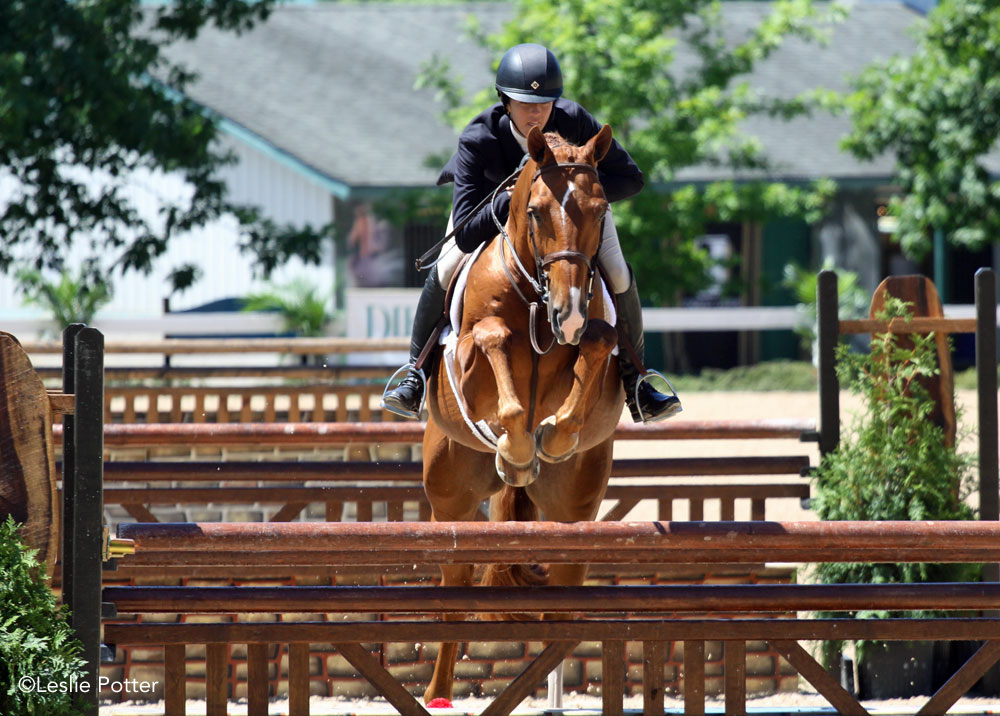Q: Most of the time my green hunter is very brave at unfamiliar jumps. But every now and then at a show, he’ll suddenly slam on his brakes without warning. Then he makes this big effort from a standstill and heaves himself over the jump. What am I doing wrong?

A: Sometimes it’s not what you’re doing wrong, but what you’re not doing at all. In this case, it sounds like you are allowing your horse to be a tourist as he motors around his courses. At the last moment before take-off, when he has to commit to leaving the ground, he is surprised by an unfamiliar jump and takes a second to evaluate it. His momentary pause takes away his momentum, and he loses his balance, while you are caught asleep at the wheel. The jumping effort is a disaster. But you can fix this.
First, go back to working on the flat at home. Make sure your horse respects your aids. When you ask him to increase his pace or lengthen his stride by closing your leg, he should respect that. The same thing goes for your hand. When you half-halt and ask him to collect or slow down, he should do so willingly. All of this will make him a more adjustable horse to ride over fences and will keep him focused on his job. Horses that sightsee while they’re jumping are more likely to have trouble on course because their attention is outside the arena.
Another tip is to construct small schooling jumps at home that simulate what astounds him in the show-ring. Don’t try to scare your horse, but do attempt to hold his interest so that he’s not stunned when he finds them in the show ring.
Finally, know your horse’s habits. When you study the posted course at a show, recognize the jumps that might surprise your horse. Plan ahead. About four or five strides away from those jumps, check in with your horse. Half-halt a little, add a squeeze of your leg, perhaps cluck to him. In some manner, let him know that you’re on board and that the two of you are leaving the ground when he arrives at the base of the jump. Let your aids be his wake-up call.






good info
good info
I have had this problem before and it’s really nice to find a way to help solve it.
I have a problem with my horse that whenever i’m about to jump he slips to the side. He never used to do that and know i dont know what to do. It’s driving me crazy becouse on shows he does the same thing.
can someone tell me what to do ???
I need some HELP with my 11 year old gelding. He is a Russian-Arabian and every time i try to jump im he naps every time, except when he is right on top of another horse in front of him. He has thrown me a time or two. I have had a professional come to help me with him and he did fantastic with her but when she left he went right back to napping.
I really need some help from any one who can.
I forgot to say that the question above is great and I love the answer you gave the person.
ok so i have a 13yr old appendix quarter horse and i would like to start jumping him. i have free lunged him over 3ft jumps and it looks like he might be able to go higher. but heres my problem, when ever i ride him around jumps he gets too forward and wont collect. when ever i jump him he runs and either jumps it way to high or stops dead and sends me flying, or run out and completly ovoids the jump
This really helped with my horse. She was a reining horse efore a hunter-jumper, and she finds it very fun to slide right before a jump. She now understands that she has to go over the jumps and not into it. She is now up to 4 ft jumps! I know this has nothing to do with the decorative jumps but it still helped me.
I think this is very good advice. Keeping your horse focused on the job at hand and in front of your leg aid is good advice.I have found that some horses don’t clearly understand what the leg aid means. I suggest that riders go back to doing leg yields and the basics of ground work to clearly teach horse what is expected of him when the leg aid is used. I also have seen that in this country riders are taught to ride in a “Hunt Seat” or Half seat before they even get to jump. I believe this is one of the reasons horses will refuse or duck out on a jump. The rider is ahead of the horse. The rider should sit a bit deeper on the approach and get horse “In front” of their leg and then go into a 2 point when horse is committed to jump and actually has lifted his front end up to go over jump.
Thanks
My horse refuses at logs on the trail a lot. I ride bareback, but when I feel that my horse is about to put on the breaks, if i know that she’s going to stop, i like to drop me heels and sit deep. It keeps me on.